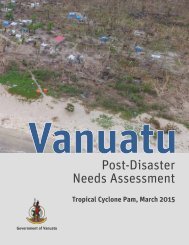Fiji
yqgk302EGjo
yqgk302EGjo
You also want an ePaper? Increase the reach of your titles
YUMPU automatically turns print PDFs into web optimized ePapers that Google loves.
FIJI Post-Disaster Needs Assessment<br />
the commerce subsector arising from primary losses in the agriculture, livestock and fisheries subsectors. A good number<br />
of large retail outlets and the majority of wholesalers surveyed had insurance coverage. Most of the damage occurred in<br />
commercial establishments located in the Western and Northern Divisions.<br />
The total value of disaster effects for the commerce sector is estimated as F$10.4 million, of which F$2.5 million refers to<br />
the value of destroyed assets, and F$7.9 million represents decline in sales, as shown in Table 27.<br />
Manufacturing: For the manufacturing sector, information was obtained through a sample survey on: the estimated value<br />
of destroyed physical assets, including premises, equipment and machinery, stocks of raw materials for processing, and<br />
stocks of finished goods; and the value of stoppage or slowdown of production and sales and other operation-related<br />
problems (including the absence of electricity and employees). In some cases, businesses underwent higher production<br />
costs due to increased transport and electricity costs. Businesses which depended primarily on produce reported significant<br />
losses, in particular, in the pearl industry, where the only manufacturer highlighted a limited supply forecast resulting from<br />
massive damage to all pearl farms across <strong>Fiji</strong>. A total of 70 individual manufacturing companies from the Western, Northern<br />
and Central Divisions submitted their responses to the survey.<br />
In addition to production losses, a total of 554 short-term job losses in the formal sector was reported in manufacturing<br />
companies during the two weeks after the cyclone. The jobs were reinitiated once the electricity supply was fully restored.<br />
No employment or livelihood losses were reported in the informal sector.<br />
The sugar milling industry was also heavily affected. Milling facilities located in in the Western Division were significantly<br />
damaged, in particular the Penang Mill in Rakiraki, the Rarawai Mill in Ba and the Lautoka Mill. In addition, the rail network<br />
for carting cane was damaged. Impact on production due to temporary closure of the Penang Mill, the anticipated shortage<br />
of sugar cane, and higher energy and transport costs contributed to the losses. Total damage to sugar manufacturing<br />
stands at F$60.2 million and production losses were estimated at F$42.8 million.<br />
In addition, a comprehensive survey conducted by the National Centre for Small and Micro Enterprises Development found<br />
that 272 enterprises were affected. In addition, the Ministry of Industry, Trade and Tourism (MITT) conducted a survey<br />
revealing that 1,857 clients incurred damage to fixed assets (furniture, fittings, equipment and stock) and production<br />
losses. The types of businesses affected included canteens, roadside stalls, market vendors, barbershops, catering, grass<br />
cutting and handicrafts. Based on field surveys, an estimated 84 out of the 443 registered communally owned cooperatives<br />
also recorded damage and losses.<br />
The total value of disaster effects for the manufacturing subsector are estimated at F$132.4 million, of which F$70.4 million<br />
refer to the value of destroyed assets, and F$62.0 million represent the value of production decline, as shown in Table 27.<br />
Table 27: Damage and Losses in Commerce and Manufacturing by Subsector (F$ million)<br />
Commerce<br />
Damage Losses Total Effects<br />
Public Private Total Public Private Total Public Private Total<br />
Wholesale and retail trade 2.5 2.5 7.9 7.9 10.4 10.4<br />
Manufacturing<br />
Sugar milling 40.9 19.3 60.2 29.1 13.7 42.8 70.1 33.0 103.1<br />
Processing of non-sugar food and<br />
non-food products<br />
Informal sector SME<br />
manufacturing<br />
6.8 6.8 8.0 8.0 14.7 14.7<br />
3.4 3.4 11.2 11.2 14.6 14.6<br />
Manufacturing subtotal 40.9 29.5 70.4 29.1 32.9 62.0 70.1 62.3 132.4<br />
Total 40.9 32.0 72.9 29.1 40.8 69.9 70.1 72.7 142.8<br />
Source: Estimations by Assessment Team.<br />
Note: Small and medium enterprises are considered informal sector activities that contribute to the manufacturing sector, as treated in the<br />
classification of national accounts for <strong>Fiji</strong>. Small and medium enterprises and cooperative businesses are considered informal sector activities<br />
that contribute to the commerce sector, as treated in the classification of national accounts for <strong>Fiji</strong>. However, figures on these damage and<br />
losses were not readily available at the time of the assessment. They have subsequently been made available and were estimated to total<br />
F$2.07 million in damage and F$5.98 million in losses.<br />
Tropical Cyclone Winston, February 20, 2016<br />
55



